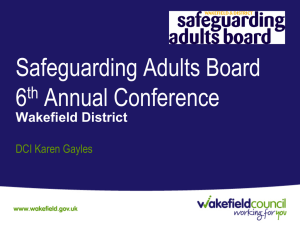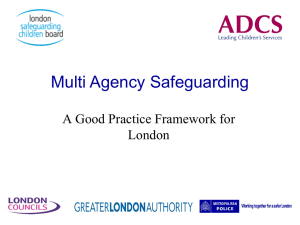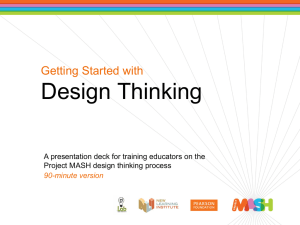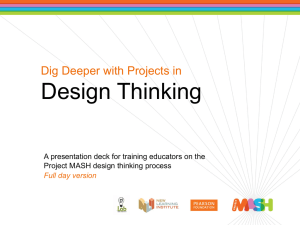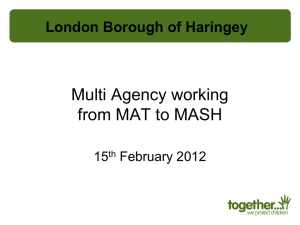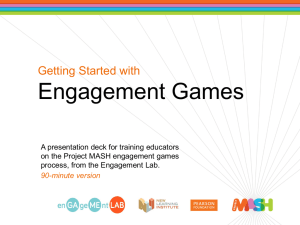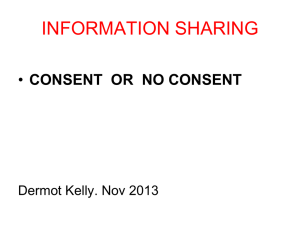MASH (Multi Agency Safeguarding Hub)
advertisement
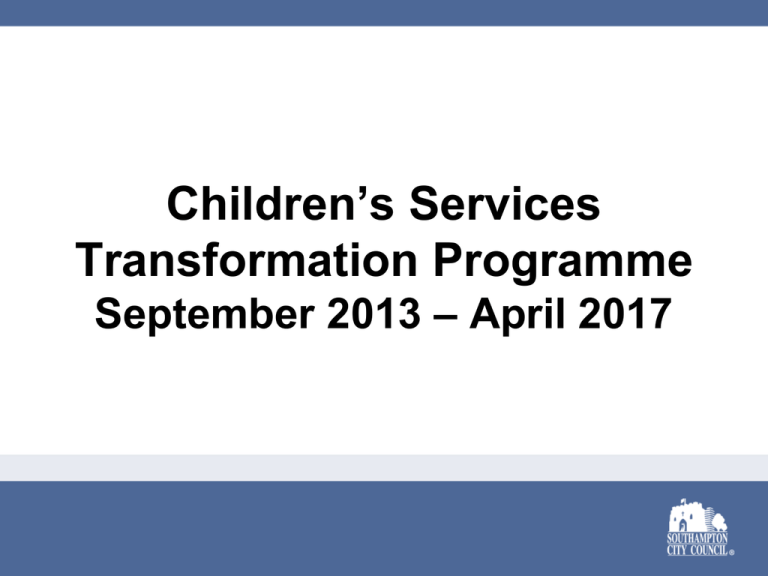
Children’s Services Transformation Programme September 2013 – April 2017 The Case for Change • • • • National Drivers The World Today for Our Children Evidence to support the proposals 7 Key Themes National Drivers for Change • • • • • Compelling evidence locally and nationally of the need to deliver evidence based interventions; Graham Allen’s report “Early Intervention – the next steps” highlights the impact that effective early intervention has had on outcomes for children and families through the UK Munro recommendations for child centred approach and continuous relationship with family New statutory guidance safeguarding and adoption Children & Families Bill, Family Justice review New inspection regime with stronger focus on Early Intervention The World Today for Our Children • • • We have 26% more (than statistical neighbours) hospital admissions for deliberate or accidental injury and significantly higher admissions for alcohol and substance misuse for young people. Sexual health is generally worse than our comparator areas Teenage pregnancy rates are 17% higher than statistical neighbours and rank Southampton 142/152 LA’s The World Today for Our Children • • Child and Adolescent Mental Health outcomes are relatively poor compared to the national picture and was ranked worst in the comparator group for the emotional health of its children. Domestic Violence accounts for 20% of all violent crimes. The number of cases being presented to MARAC is double the national average and the recent audit of children subject of a Child Protection plan defined 80% of the families as having domestic violence as a feature. The World Today for Our Children • Whilst our educational outcomes for children have been steadily improving from a very low base over recent years we continue to perform poorly in measures relating to absenteeism and levels of fixed term exclusions: Total absence from school – 5.9% (England 5.1%) giving the city a rank of 147/152 Total persistent absence -7.6% (England 5.2%) giving the city a rank of 149/152 Fixed Term exclusions from school 7.6% (England 5.2%) giving the city a rank of 150/152 The World Today for Our Children • • • The levels of first time offending and reoffending in our young people are also too high and outside of the range of performance of our statistical neighbours ranking us 145/152 and 144/152 LA’s. The demand for Social Care Services across the spectrum is disproportionate (usually to about 30% higher) to our statistical neighbours. The excessive demand for our services across the board has lead to an overspend of almost £5m Evidence to Support the Proposals • • • A review of cases and service pathways for children has shown significant systems failure at the interface between tier 2 and 3 services and within individual services and agencies. It takes too long for children and their families to access services and where they do they experience both duplication and gap. Informal consultation with partners and feedback from our customers has identified service gaps, duplication and confusion in our present service design. • • • Evidence to Support the Proposals Families were frequently not seen as meeting a threshold for Tier 3 or 4 services and referred for a lower level of intervention without any sufficient systems in place to track the outcomes of this determination. Once families did access services there was insufficient rigour in the virtual Team around the Family (TAF) process to evidence the work in place or to be confident that each member of the TAF understood their role, responsibility and required activity. The LSCB has not been rigorous enough in its challenge of agencies and adherence to procedures. • So here’s the good news …… We are Ambitious for Change • • • • We are on a road of continuous improvement – all staff and managers appreciate and recognise the improvements to be made in the front line practice of our services, our systems and our interagency collaboration. A relentless attention to improving the outcomes of our children is being driven by a clear vision of an aspirational and ambitious peoples directorate and exceptionally strong partnerships. We can and will transform our services this year to ensure that we have a stronger focus on Early Help with clearer pathways that allow families to access services earlier. Whilst also ensuring the pursuit of timely permanency for all of our looked after children through a diverse range of routes Our Vision An Early Intervention City with a multi agency integrated service provision that works to ensure children's needs are met at the earliest stage. “ Where possible, and children's welfare is assured, these needs will be met within their family and community resources. ” Seven Key Themes • • • • • • • A good Education for all The earliest help Integrated, co-managed, co-located, seamless services Evidence based practice Good quality care provision for LAC Stronger Quality Assurance Our workforce to be better trained and supported How do we get there? • • • • Transformation of services with minimal service disruption over next 2/3 years in two distinct phases, with a structured programme of improvement running in parallel Re-engineering of service provision across the city, directly provided or commissioned Merger of CYP Commissioning, Education & Children’s Social Care and the creation of five new service streams Establishment of Joint Commissioning Unit Transformation of Services • • • • • • • A single point of contact for safeguarding concerns regarding children and young people through a Multi Agency Safeguarding Hub (MASH) Integrated Early Help services for 0-4 and 5-19 year olds Threshold Criteria to be reviewed to create 3 tiers; Universal, Enhanced and Specialist Creation of Integrated Family Assessment & Intervention Service (IFAIS) Integrated service offering for 14+/Care Leavers Service & Permanent Care of our Looked After Children Quality Assurance Unit built on national best practice SEND 0-25 Service Changes to Management Structure New Single Head of Children and Families Services post reporting directly to Director of People 5 New Principal Officer posts reporting to Head of Children and Families Services People Director Head of Children’s Services Principal Officer Front Door & Early Help Principal Officer Early Years & Education Principal Officer Core Specialist Teams Principal Officer Resources & Provision Principal Officer Quality Assurance Business Unit (holds PSW role) Early Years & Education Service • • • • • • • • • • Standards and School Improvement including governor support School Organisation and Planning Virtual School Head Teacher & team Admissions, Children missing education, Elective home education Music Service SEND Service for 0-25 Lead officer Early Years with oversight of – Early Years Teachers Start Point Sholing and Northam Early years & Childcare Planning Staff Two year old offer Children’s Centres EWN and C Front Door & Early Help Service • • • • • Multi-Agency Safeguarding Hub (MASH) Child Protection Investigation & Assessment Team Early Help Assessment Lead Officers 0-4 Early Help Service 5-19 Early Help Service Core Specialist Teams Service • • • • Six core social work teams Integrated Family Assessment & Intervention Service (incorporating SAT, BRS, and the contact service) Integrated Domestic Violence Service Youth Offending Service Resources & Provision Service • • • • • • • Acts as Agency Decision Maker for fostering Fostering Service Private Fostering Adoption Service Permanent Care – Looked After Children Team 14+ and Care Leavers Service Links to ICU for all children commissioning Quality Assurance Business Unit • • • • • • • • • Acts as Agency Decision Maker (ADM) for Adoption Team manager & staffing for Independent Reviewing Officers and Child Protection Chairs and Fostering Household Reviewing Officer Inspire Practice Educator Lead and Children’s Workforce Development Staff Local Authority Designated Officer (LADO) LSCB Manager and administration for LSCB and LSAB Lead Officer for Permanency Assurance (adoption adviser) Lead Officer for Safeguarding Assurance Lead Officer for Adults and Housing Audit Programmes Workforce Development • • • • New Advanced Practitioner who will have themed strategic lead and carry complex cases Enhanced Professional Development Framework Targeted training programmes to support new services Recruitment and retention strategy to find, grow and develop the best talent Proposed Timeline Phase One July 2013- December 2013 Listening Phase - Informal Consultation 16th December – 7th February Senior Management Consultation Formal Consultation with staff forming the Quality Assurance Unit MASH and Child Protection Team. SCC staff to be included in the 0-4 and 5-19 services and the IFAIS End of March 2014 MASH and Early Help Teams in place. Senior Team recruitment complete. Proposed Timeline Phase Two • 7th April - 23rd May 2014 SEND 0--24 Service Formal consultation for Service to go live in September 2014. May to July 2014 PACT looked after Children Teams and all remaining services reshaped. Multi Agency Safeguarding Hub - An integrated real time front door. - Core partners; Social Care (governance lead), Police, Health, Education (schools and settings). - Additional partners; Probation, Housing, Adult Services and the Voluntary Sector MASH The by product, that is ultimately the essential strategic gain, is a quicker, co-ordinated response and a rich database of demand, need and service provision - The MASH Team receive contacts for children where there is a concern. - A RAG rating system prioritises where there is a need to act within clearly prescribed timescales The information sharing is immediate and each agencies “navigators” take responsibility for the co-ordination of their own network MASH MASH information officers first check if the child already has a social worker. If there is an allocated social worker, they are considered to be the best person to support the child, so the case is referred directly to them. If there is no social worker, then the MASH information officers assess the level of risk. The MASH manager confirms the risk level with a BRAG rating MASH BRAG rating definitions Red: There is a potential child protection issue (e.g. serious injury to the child). Requires immediate action, and information from MASH navigators is expected within 2 hours. Amber: There are significant concerns but immediate action is not required (e.g. ongoing domestic violence issues in the household). Requires information from MASH navigators within 6 hours. Green: There are concerns regarding a child’s wellbeing but these do not meet statutory requirements (e.g. poor school attendance). Requires information from selected MASH navigators within 24 hours. Blue: There is no safeguarding concern and the issue can be dealt with by a Universal service. No MASH response required. Advice or referral to a Universal service may be provided. What happens Next The MASH manager uses the collected information to decide the best response to meet the child’s needs. The manager may: Refer the case to the Child Protection team; Refer the case to another social work team, a multi-disciplinary team, or a Universal service; or Close the case with no further action. The service that receives the case will receive a summary of any appropriate information gathered by the MASH. The referrer will be notified in writing of the outcoem of their referral MASH Structure Chart MASH Manager Advanced Practitioner Social Worker Social Worker Police Team Nos. TBC Advanced Practitioner Social Worker Early Years Navigator Early Help Adviser Education Navigator Early Help Adviser Health team Probation Nos.TBC Social Worker Screener Screener Screener Screener Screener Housing Adults Services VolOrgs Navigator Child Protection Team Team Manager Advanced Practitioner Advanced Practitioner Social Worker Social Worker Social Worker Social Worker Social Worker Social Worker Where can I find out more? www.yammer.com/southampton.gov.uk change.programme@southampton.gov.uk http://intranet.southampton.gov.uk/change/
